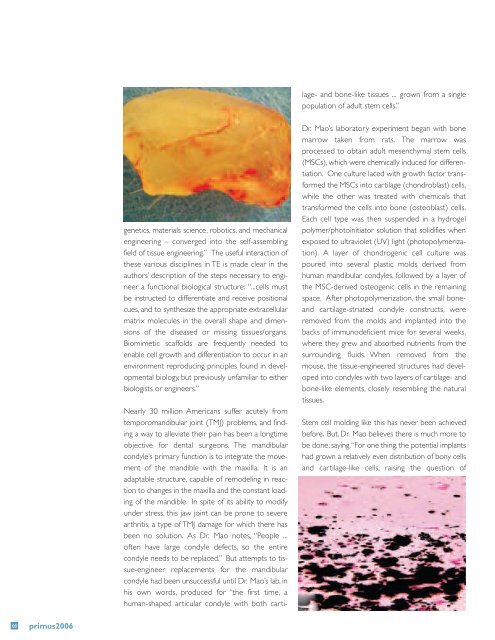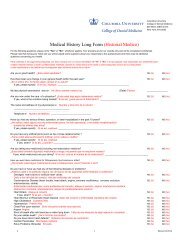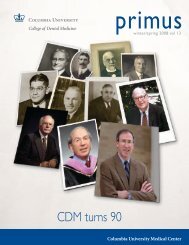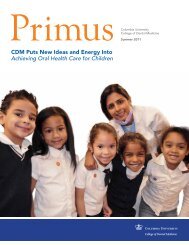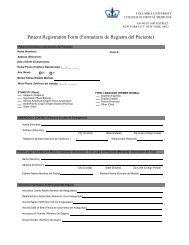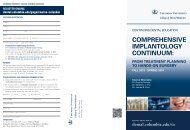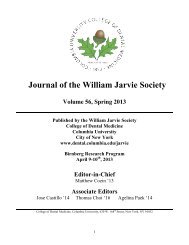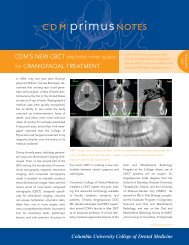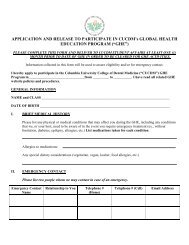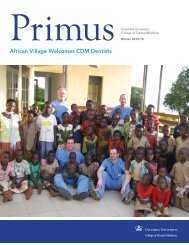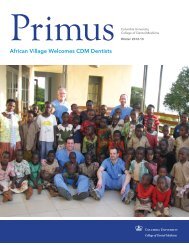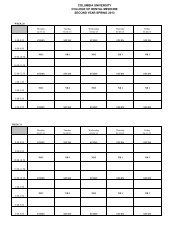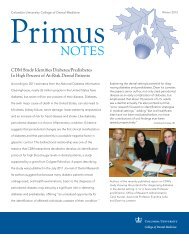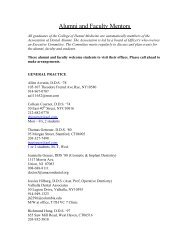Fall 2006 - College of Dental Medicine - Columbia University
Fall 2006 - College of Dental Medicine - Columbia University
Fall 2006 - College of Dental Medicine - Columbia University
Create successful ePaper yourself
Turn your PDF publications into a flip-book with our unique Google optimized e-Paper software.
lage- and bone-like tissues ... grown from a singlepopulation <strong>of</strong> adult stem cells.”genetics, materials science, robotics, and mechanicalengineering – converged into the self-assemblingfield <strong>of</strong> tissue engineering.” The useful interaction <strong>of</strong>these various disciplines in TE is made clear in theauthors’ description <strong>of</strong> the steps necessary to engineera functional biological structure: “...cells mustbe instructed to differentiate and receive positionalcues, and to synthesize the appropriate extracellularmatrix molecules in the overall shape and dimensions<strong>of</strong> the diseased or missing tissues/organs.Biomimetic scaffolds are frequently needed toenable cell growth and differentiation to occur in anenvironment reproducing principles found in developmentalbiology, but previously unfamiliar to eitherbiologists or engineers.”Nearly 30 million Americans suffer acutely fromtemporomandibular joint (TMJ) problems, and findinga way to alleviate their pain has been a longtimeobjective for dental surgeons. The mandibularcondyle’s primary function is to integrate the movement<strong>of</strong> the mandible with the maxilla. It is anadaptable structure, capable <strong>of</strong> remodeling in reactionto changes in the maxilla and the constant loading<strong>of</strong> the mandible. In spite <strong>of</strong> its ability to modifyunder stress, this jaw joint can be prone to severearthritis, a type <strong>of</strong> TMJ damage for which there hasbeen no solution. As Dr. Mao notes, “People ...<strong>of</strong>ten have large condyle defects, so the entirecondyle needs to be replaced.” But attempts to tissue-engineerreplacements for the mandibularcondyle had been unsuccessful until Dr. Mao’s lab, inhis own words, produced for “the first time, ahuman-shaped articular condyle with both carti-Dr. Mao’s laboratory experiment began with bonemarrow taken from rats. The marrow wasprocessed to obtain adult mesenchymal stem cells(MSCs), which were chemically induced for differentiation.One culture laced with growth factor transformedthe MSCs into cartilage (chondroblast) cells,while the other was treated with chemicals thattransformed the cells into bone (osteoblast) cells.Each cell type was then suspended in a hydrogelpolymer/photoinitiator solution that solidifies whenexposed to ultraviolet (UV) light (photopolymerization).A layer <strong>of</strong> chondrogenic cell culture waspoured into several plastic molds derived fromhuman mandibular condyles, followed by a layer <strong>of</strong>the MSC-derived osteogenic cells in the remainingspace. After photopolymerization, the small boneandcartilage-striated condyle constructs, wereremoved from the molds and implanted into thebacks <strong>of</strong> immunodeficient mice for several weeks,where they grew and absorbed nutrients from thesurrounding fluids. When removed from themouse, the tissue-engineered structures had developedinto condyles with two layers <strong>of</strong> cartilage- andbone-like elements, closely resembling the naturaltissues.Stem cell molding like this has never been achievedbefore. But, Dr. Mao believes there is much more tobe done, saying,“For one thing, the potential implantshad grown a relatively even distribution <strong>of</strong> bony cellsand cartilage-like cells, raising the question <strong>of</strong>08primus<strong>2006</strong>


